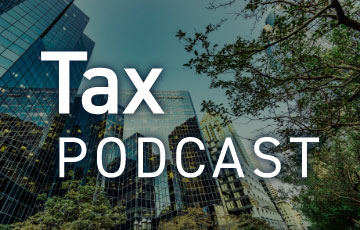Introduction to the Federal TCJA & SALT Deduction Cap Expiration
The controversial state and local tax (SALT) cap will expire this year unless subsequent legislation extends the tax provision or establishes it as a permanent fixture of the Internal Revenue Code.
Part of the 2017 Tax Cuts and Jobs Act (TCJA) signed into law during President Donald Trump’s first administration, the SALT cap established a $10,000 limit on the amount of deductible state and local taxes for many individual taxpayers. In the following scenarios, we explore how the future of the SALT cap may impact state pass-through entity tax (PTET) regimes, which were established to provide relief to individual taxpayers.
Key Takeaways
- Many states adopted pass-through entity (PTE) tax regimes to help provide relief to individual taxpayers affected by the SALT cap.
- Most state PTE tax regimes will continue even if the SALT cap does not exist on a federal level.
- The SALT cap could be extended at its current $10,000 level to pay for other tax agenda items, meaning current PTE tax regimes would likely remain unchanged.
- Congress may take action to extend the SALT cap with an increased limit, which would benefit high-income, high-net-worth taxpayers.
- If the SALT cap is eliminated entirely, it is likely state PTE tax regimes would also sunset.
Understanding the Pre-2018 Tax Deduction Landscape
Impact of the SALT Cap on Individual Taxpayers
Prior to 2018, individual taxpayers who itemized deductions on their federal income tax return could fully deduct, without limitation, amounts paid to states and local jurisdictions for taxes such as income taxes on wages and property taxes on their home.
Beginning in 2018, the itemized deduction for state and local taxes was limited to $10,000 per return for:
- Single filers
- Head of household filers
- Married taxpayers filing jointly (the so-called marriage penalty)
- And $5,000 each for married taxpayers filing separately
Taxpayers who paid state and local taxes above these limits during the tax year lost the additional deduction for federal income tax purposes.
State Responses: PTE Tax as a Workaround
The SALT cap applies only to individual taxpayers, not business entities. Thirty-six states have provided relief to individual taxpayers affected by the limit through legislation allowing an optional, entity-level income tax on pass-through entities (PTEs), such as partnerships and S corporations.
For federal and state income tax purposes, income taxes are not typically imposed on PTEs at the entity level. The income is passed through and taxed on the owner’s return. A partnership or S corporation electing to pay a state’s optional PTE tax could take a federal income tax deduction for the PTE taxes paid. This results in a lower proportionate share of business income reported by owners on their federal income tax returns, effectively circumventing the TCJA’s $10,000 SALT cap.
IRS Guidance on PTE Taxes
In Notice 2020-75, the IRS announced proposed regulations to explain how state income taxes imposed on PTEs at the entity level could be a permissible deduction by the pass-through entity in computing its non-separately stated taxable income or loss for the tax year of the payment.
As of January 2025, the IRS has neither issued these proposed regulations nor indicated if they will be issued before the planned sunset of the SALT cap. Until the proposed regulations are issued, Notice 2020-75 provides that taxpayers may rely on the notice, which allows the entity-level state income tax deduction.
Post-Election Federal Tax Policy: What's Next for the SALT Cap?
Although the SALT cap is set to expire after 2025 as part of TCJA, its future impact on states that enacted PTE tax workarounds depend on the tax policy agenda of the Trump administration and Congress.
Republicans have several tax measures planned for potential legislation, but the fate of the SALT cap remains uncertain. Federal lawmakers may let the SALT cap expire, extend it at the current limit or raise it beyond 2025.
Scenario 1: Sunsetting the SALT Cap
The legislation enacted by most (i.e., 26) of the 36 states that established a PTE tax election provides that the elections shall remain in effect indefinitely. In other words, the states’ PTE tax regimes will continue to exist even if the SALT cap is no longer imposed at a federal level until the state repeals the option for taxpayers to make a PTE Tax election.
The remaining 10 states with PTE Tax elections enacted legislation that either automatically repeals the election for tax years when the SALT cap is no longer in effect, or provided that the PTE tax election is available only through 2025 to coincide with the sunset of the federal SALT cap.
Most states designed their PTE tax regimes to be revenue-neutral for taxpayers, offsetting the income tax paid by the entity and taken as a federal deduction by the entity with an equal deduction or credit against the taxable income or liability of their individual owners.
A handful of states, such as Connecticut and Massachusetts, took a different approach in that owners do not receive a dollar-for-dollar tax credit. In Connecticut, owners receive a credit of 87.5% of the PTE tax paid by the entity, and in Massachusetts, 90%. If the SALT cap sunsets, some states may continue their PTE tax regimes but with a less-revenue-neutral approach going forward. Similar to Connecticut and Massachusetts, this tax regime is a way of passing along the continued administrative costs to the taxpayers that may still capture a benefit by taking the PTE tax election.
Potential Outcomes
In this scenario, the primary benefit and intended purpose of the PTE tax election, when enacted, would no longer be the federal deduction. In practice, PTE tax elections have been shown to provide other benefits, such as simplifying owner tax compliance. Many states provide that the election and payment of the PTE tax by the entity satisfies the filing requirement of its non-resident owners.
This is particularly beneficial for pass-through entities with high partner or shareholder counts where each owner might otherwise (without an election) be required to file their own return with each state. Likewise, this approach could also be beneficial for the state as it could collect taxes from income earned in the state at the source.
Without a federal SALT cap, it is likely many states would see PTE tax elections as unnecessary and costly to administer. As such, if the cap expires states with PTE tax regimes will likely not take action to renew them further, and states with regimes that continue indefinitely would take legislative action to end their elections rather than keeping them.
Scenario 2: Extending the SALT Cap at $10,000
A second potential option is that there will be an extension of the SALT cap but at current limits.
Despite campaign promises by President Trump to eliminate the SALT cap, a member of Trump’s economic advisory transition team recently stated the group has considered raising the limit from $10,000 to $20,000.
This could indicate that the expiration of the SALT cap after 2025 might prove too costly to consider. Competing priorities on the tax policy agenda may necessitate continuing the SALT cap at current limits to pay for President Trump’s proposals to eliminate income taxes on Social Security benefits, tips and overtime pay. This is in addition to continuing numerous other TCJA policies expiring after 2025, such as the Section 199A Qualified Business Income deduction and the increased estate and gift tax exclusion.
Potential Outcomes
In 2023, Congress's Joint Committee on Taxation projected that the expiration of the SALT cap could raise the deduction’s cost from $22 billion in 2025 to $139 billion in 2026. This projection makes the odds of the SALT cap sunsetting after 2025 seem less likely. It is more likely the SALT cap will continue in some form to pay for other items on the tax agenda.
In this scenario, six states (Colorado, Iowa, Massachusetts, Michigan, Minnesota and Oregon) will automatically continue their PTE tax regime as long as any limitation to the state and local tax deduction is in place for a tax year under Section 164. If Congress were to extend the SALT cap at current limits, only the PTE tax regimes of California, Illinois, Utah and Virginia would require legislation to continue beyond 2025.
If the SALT cap is extended beyond 2025 at the current $10,000 limit, states will likely keep the existing PTE tax election systems since the original reason for their creation still applies.
Scenario 3: Increasing the SALT Cap Limit Beyond $10,000
An increasingly likely possibility is that Congress could take legislative action to continue the SALT cap beyond 2025 but increase the allowable deduction above the TCJA’s $10,000 maximum.
Options being considered in a House Ways and Means Committee report include:
- Eliminating the marriage penalty, which would keep the cap at $10,000 for individual taxpayers
- Doubling the allowable deduction to $20,000 for married couples filing jointly
- Increasing the cap to $15,000 for individuals and $30,000 for married couples
While an increase in the SALT cap limit is perhaps the most difficult to predict regarding the state response to PTE tax regimes, the result would likely fall somewhere between the SALT cap sunset and extension at the current $10,000 limit.
Potential Outcomes
The continuation of the SALT cap at some level above $10,000 would leave a reason for PTE tax regimes to exist that aligns with their intended purpose as a workaround to the cap. The pool of potential taxpayers who would benefit from the state PTE tax election would decline as the limit rises above the current $10,000 cap.
For many taxpayers, an increased limit of $20,000 would sufficiently cover their state and local tax liabilities. As a result, a state PTE tax election would most benefit high-income or high-net-worth taxpayers with annual liabilities of $20,000 and above for state income or property taxes above. State lawmakers may choose to phase out PTE tax regimes if increased federal caps result in reduced levels of taxpayer participation that do not support the administrative costs of continuing the programs further.
Scenario 4: Eliminating the SALT Deduction Altogether
Another potential option, albeit a less likely one, is for federal lawmakers to counter the state PTE tax workarounds by eliminating the business SALT deduction entirely while leaving the individual limit intact.
This option is being considered in the recent House Ways and Means Committee report and is discussed in an article by the Bipartisan Policy Center.
Another option the House Ways and Means Committee is considering is to repeal the SALT deduction for both individual and business taxpayers. This option is estimated to a save as much as $1 trillion over 10 years. Although these measures may seem drastic, Congress might use them as a compromise during the budget process to allow for a higher SALT cap for individual taxpayers or other items.
Potential Outcomes
Should either of these options be passed into law, the state response to PTE tax elections would likely be similar to those described in the first scenario. In both scenarios, the primary purpose of the PTE tax election as a workaround to the SALT cap would no longer exist. If the SALT deduction were to be eliminated for businesses or all taxpayers entirely, the states might repeal their PTE tax election regimes or allow them to expire instead of continuing to carry the costs of administering the PTE tax regimes further.
The Future of SALT Cap and State PTE Tax Regimes: Your Guide Forward
The future of the federal SALT cap beyond 2025 will have far-reaching implications for taxpayers and states, particularly those that have enacted PTE tax legislation in response to the initial $10,000 SALT cap. Whether the SALT cap expires or is extended, states must act to protect their tax bases and provide relief if deemed equitable and fiscally responsible.
While PTE taxes have proven to be an effective workaround, their relevance and benefit will depend on the federal tax policy of the current administration and Congress and how the tax agenda materializes in the months and years ahead.
Contact Cherry Bekaert’s State & Local Tax team to learn how we can help you navigate the latest PTE tax updates.









